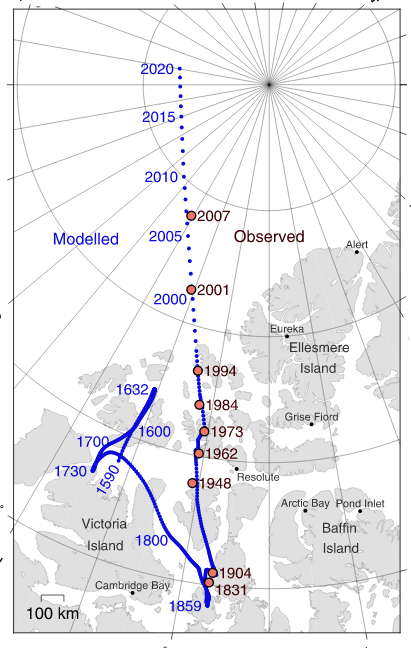Notes on the Migration of the geo-magnetic Poles

|
It has been long understood that dip poles migrate over time.
In 1831, James Clark Ross located the north dip pole position in northern Canada.
The positions of the magnetic poles can be defined in two ways: locally or globally.
The local definition is the point where the magnetic field is vertical.
This can be determined by measuring the Inclination.
The Inclination of the Earth's magnetic field is 90° (downwards) at the
North Magnetic Pole and -90° (upwards) at the South Magnetic Pole.
The two magnetic poles wander independently of each other and are not directly opposite
each other on the Globe.
The geo-magnetic poles are not geometrically fixed over time because the geo-magnetic field
is produced by the motion of the molten iron alloys in the Earth's outer core.
Because of their fluid nature, the position of these convective regions is in a constant migration.
Movements of up to 40 kilometres per year have been observed for the North Magnetic Pole.
Over the last 180 years, the North Magnetic Pole has been migrating North-West-ward,
from Cape Adelaide in the Boothia Peninsula in 1831 to 600 kilometres from Resolute Bay in 2001.
|
The global definition of the Earth's field is based on a mathematical model.
If a line is drawn through the center of the Earth, parallel to the moment of the
best-fitting magnetic dipole, the two positions where it intersects the Earth's surface
are called the North and South geo-magnetic poles.
If the Earth's magnetic field were perfectly dipolar, the geo-magnetic poles and magnetic
dip poles would coincide and compasses would point towards them.
However, the Earth's field has a significant non-dipolar contribution, so the poles do
not coincide and compasses do not generally point at either.
The magnetic equator is the line where the inclination is zero (the magnetic field is horizontal).
Location
Considerably more efforts have been spend on tracking the location of the North Magnetic Pole than
on tracking the location of the South Magnetic Pole.
The Natural Resources Canada (NRCan) tracked the North Magnetic Pole, which is slowly drifting
across the Canadian Arctic, by periodically carrying out magnetic surveys to
reestablish the Pole's location from 1948 to 1994.
An international collaboration, led by a French fundraising association, Poly-Arctique,
and involving NRCan, Institut de Physique du Globe de Paris and Bureau de Recherche Geologique et Miniere,
elaborated additional locations of the North Magnetic Pole in 2001 and 2007.
The most recent survey determined that the Pole is moving approximately north-northwest at 55 km per year.
As of 2020, North geo-magnetic Pole is located at 86.502°N 164.036°E.
The South geo-magnetic Pole is the point where the axis of the best-fitting tilted dipole as defined
in the global definition, intersects the Earth's surface in the southern hemisphere.
As of 2020, it is located at 64.073°S 135.877°E off the antarctic mainland.
|
